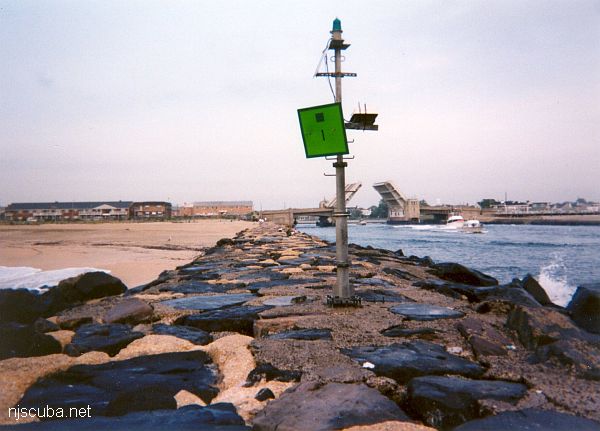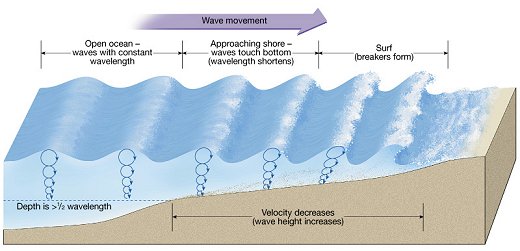Inlet & Beach Diving

If you are used to falling off a boat into the clear, warm, sunny Caribbean, and then being helped back into the boat after a nice drift, then a Jersey inlet dive may be something of a shock to you. Inlet diving requires more confidence and diving ability than almost any other kind of recreational diving.
Entry and exit in full scuba gear tend to be a lot more strenuous and difficult, whether on rocks or sand. Good balance and a fair amount of strength and agility will probably be required. In addition, one needs to watch the actual time and tides, and contend with a changeable current, darkness, extra gear and flag, and lowered visibility compared to the tropics. Also, buoyancy control and proper weighting* in the shallows is trickier than in a deep dive.
All of this can easily add up to stress, exhaustion, overload, panic, and a dangerous situation for an inexperienced diver. I've seen it happen, and every year another poor beginner gets into the news by dying in one of the rivers. If you've never done a northern inlet dive, then don't try one without an experienced buddy who has dived that particular spot before and knows what he is doing. Many of the local dive shops conduct organized dives of this sort where you can get some experience. The PADI Advanced Open-Water course will also give some of this training. It also helps to have a willing friend for a shore crew, to help with gearing up, entry, and especially exit.
It is important to plan your entry and exit locations taking the current into account. Try to have the current carry you from one point to the other. If you miss your tide timing, you will be in for a difficult swim. If you are late, and you end up being carried out to sea by the river, swim across the current until you get out of it, and climb out on the beach. If you are being swept inland, just grab on to a bulkhead or something, and wait it out at the surface, or climb out there if you can. Never try to swim against a strong current, you will only exhaust yourself, and that is where the real danger begins. At the mouth of the inlet, the river current will often give way to the ocean beach current, which runs parallel to the shore. Whatever you do in this situation, stay out of the boat channel.
A final danger in inlet diving is fishermen. While most fishermen have no problem pulling their live hooks out of the water for a minute to let you pass, there is always the chance of a jerk who just doesn't care, or isn't paying attention. You will also find a lot of old lost hooks in the river to avoid. If you get hooked, it will most likely be in your gear, not in you. Unless you can get off immediately, just cut the line. For this reason, always carry a sharp knife. Sometimes the same guy that will hook you in the first place will hang around to give you grief later. Diplomacy is key here, a good dive is ruined by getting in a fight afterward. If you still have it, give his lure back to him. Sinkers found during the dive can also be used to placate an irate fisherman. In the many inlet dives I've made, I have been hooked several times, with no real harm done.

On the plus side, shore dives are usually shallow, so at least air and nitrogen are not a concern - you will run out of time ( or tide ) or get bored long before hitting any other limits. In an emergency, or if you feel the need to just get out, odds are there will be some sort of dry land close at hand, and the surface should never be more than 30 feet away. It would be unusual to make more than a one-tank dive, given the time constraints.
Once you know what you are doing, inlet diving is safe, a lot of fun, and cheap too - just the cost of the air in your tank. The rocky areas make homes for all sorts of sea life, with many photo opportunities. Every river is different, and every inlet has two different sides to explore. There is also the possibility of recovering lost articles, like bottles, fishing rods, lures, wallets, lawn furniture, dive gear, anchors, and anything else that someone might drop into the water. If you like to hunt, you can easily turn a profit on the excursion by catching fluke, blackfish, and lobsters. Its worth the extra effort.
* If using a wetsuit, add eight to ten pounds to your usual weights on the first try; you can play with fine-tuning after that. In any case, you'll want to be somewhat over-weighted, so you can settle on the bottom in the current without a problem.

